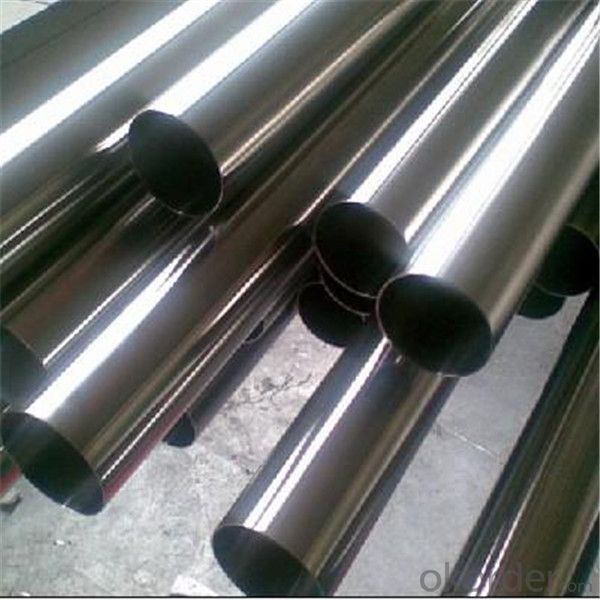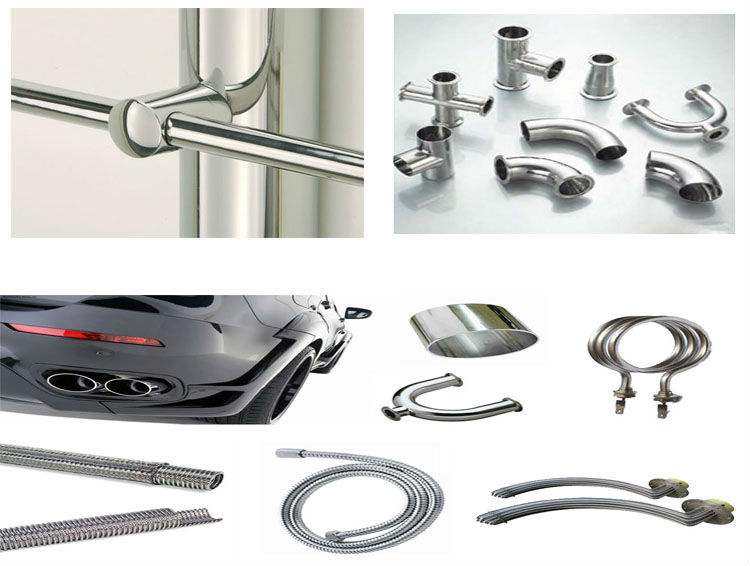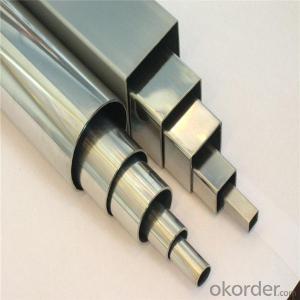304 304l 316 316l 317 317l Stainless Steel Welded Pipe
- Loading Port:
- Shanghai
- Payment Terms:
- TT OR LC
- Min Order Qty:
- 2 m.t.
- Supply Capability:
- 25000 m.t./month
OKorder Service Pledge
OKorder Financial Service
You Might Also Like
Item specifice
304 304l 316 316l 317 317l stainless steel welded pipe
1. Product Description
The details of my company | |||
The stainless steel sheet/coil/strip | |||
standard | ASTM,GB | ||
material | 201,202,301,304,316,316L,316LN,317,317L,309,309S,310,310S,430,409 | ||
specification | thickness | 0.3mm—20mm | |
width | 120mm—2000mm | ||
Production technology | Hot rolled , | ||
cold rolled | |||
Surface treatment | 2B,BA,8K,No.1,Etching,Hairline,Satin,Mirror,Vibration,Bead Blast,Embossed | ||
The stainless steel pipe | |||
standard | ASTM,GB | ||
material | 201,202,301,304,316,316L,316LN,317,317L,309,309S,310,310S,430,409 | ||
specification | Wall thickness | 0.3mm-60mm | |
Round | 6mm-630mm | ||
Square | 10*10mm-150*150mm | ||
rectangle | 10*20mm-100*200mm | ||
Surface treatment | Polishing (180#,220#,240#,320#400#,600#), Hairline,aid pickling and so on | ||
Production technology | Seamless steel pipe | ||
Welded steel pipe | |||
Surface treatment | Polishing or not | ||
The stainless steel bar | |||
standard | ASTM,GB | ||
material | 201,202,301,304,316,316L,316LN,317,317L,309,309S,310,310S,430,409 | ||
specification | Round | ||
Square | |||
rectangle | |||
Product Show
2. Product Pictures of 304 304l 316 316l 317 317l stainless steel welded pipe


3. Applications
Milk and food industry, pharmaceutical industry, industries with special internal surface requirements.

4. Stainless steel conservation
Stainless steel is a popular metal for appliances these days. Many kitchen appliances, both large and small, are made with stainless steel. Pots and pans and eating utensils are also made with stainless steel. One advantage of stainless steel is that is very resistant to rusting. But it can get rust stains from transference of rusty objects. You can keep stainless steel rust-free by following a few simple steps.
Clean frequently with a cleaner and water. Any cleaner that is safe for glass is usually safe for stainless steel.
Scrub off all rust from these objects with a scrubbing pad or steel wood pad. This means getting rid of rust from pots and pans before putting them into a stainless steel sink or on top of a stainless steel stove.
Put a rubber mat at the bottom of the stainless steel sink before placing rusted pots and pans (such as cast iron cookware) in the sink.
Apply a thin layer of lubricant (such as mineral oil) to the surface of the stainless steel. This prevents rust from forming.
Inspect equipment frequently, if you notice discoloration, tarnish or water stains, increase the frequency of your fresh water rinses to reduce accumulated chemicals
- Q:Can stainless steel pipes be used for sewage treatment plants?
- Yes, stainless steel pipes can be used for sewage treatment plants. Stainless steel is a corrosion-resistant material that can withstand the harsh and corrosive environment found in sewage treatment plants. It is highly durable and has a long lifespan, making it a suitable choice for conveying sewage and wastewater. Stainless steel pipes also have smooth surfaces, which prevent the accumulation of debris and facilitate the flow of fluids. Additionally, stainless steel is resistant to biological growth and can be easily maintained and cleaned, ensuring optimal hygiene in sewage treatment plants.
- Q:What is stainless steel pipe?
- Stainless steel pipe is a type of pipe made from an alloy of steel and chromium, with a high resistance to corrosion and staining. It is commonly used in various industries, including construction, automotive, and manufacturing, due to its durability and ability to withstand harsh environments.
- Q:What are the specifications of stainless steel decorative pipes?
- The steel pipe seamless steel pipe and welded steel pipe (seamed pipe) two categories. It can be divided into round tube and special-shaped tube according to the sectional shape. The round steel tube is widely used, but there are some special-shaped steel tubes such as square, rectangle, semicircle, hexagon, equilateral triangle and octagon.
- Q:What are the different types of stainless steel pipe end connections?
- Various types of stainless steel pipe end connections are available, each designed to meet specific application and requirement criteria. Some commonly used types include: 1. Threaded connections: These connections have threads on the inside or outside of the pipe end, enabling it to be screwed onto another threaded fitting or pipe. Threaded connections are typically utilized in low-pressure applications. 2. Socket-weld connections: In this connection type, the pipe end is inserted into a socket or recess of a socket-weld fitting and then welded around the outer circumference of the pipe. Socket-weld connections are ideal for high-pressure applications and are renowned for their strength and reliability. 3. Butt-weld connections: Butt-weld connections involve directly welding the pipe end to another pipe or fitting. They are commonly found in high-pressure and high-temperature applications. 4. Flanged connections: These connections have a flange on the pipe end, which is bolted to a mating flange on another pipe or fitting. Flanged connections are used in applications that require easy disassembly or frequent maintenance. 5. Compression connections: Compression connections utilize a compression fitting to join the pipe ends. These connections are often employed in plumbing and gas supply systems due to their ease of installation. 6. Grooved connections: Grooved connections employ grooved couplings to join the pipe ends. These connections are frequently utilized in fire protection systems and are known for their swift and uncomplicated installation. Ultimately, the choice of stainless steel pipe end connection depends on the specific application, pressure requirements, ease of installation, and maintenance considerations. It is essential to consult with a professional or refer to industry standards to determine the most suitable connection type for your particular needs.
- Q:Why pickling before cleaning stainless steel pipe oil?
- On the premise of oxide, a good foundation for the formation of passive film is made, which makes the passivation film more compact and improves the passivation effect!
- Q:Can stainless steel pipes be coated?
- Yes, stainless steel pipes can be coated. Coating stainless steel pipes can provide additional protection against corrosion, improve heat resistance, and offer aesthetic enhancements. Coatings such as epoxy, polyethylene, or fusion-bonded powder coatings are commonly used to protect stainless steel pipes in various industries and applications.
- Q:What are the different sizes available for stainless steel pipes?
- Stainless steel pipes are available in a wide range of sizes, including standard sizes such as 1/8 inch, ¼ inch, ½ inch, 1 inch, 2 inches, and larger sizes such as 6 inches and beyond. These sizes are commonly used for various applications in industries such as construction, plumbing, and manufacturing. Additionally, stainless steel pipes can also be custom-made to meet specific requirements, offering even more flexibility in sizing options.
- Q:What is the external coating used for stainless steel pipes?
- The external coating used for stainless steel pipes can vary depending on the specific application and requirements. However, one commonly used external coating for stainless steel pipes is a layer of epoxy or polyethylene. This coating provides protection against corrosion, abrasion, and other environmental factors. It helps to extend the lifespan of the pipes and ensures their durability in various industries such as oil and gas, chemical processing, and water distribution. Additionally, this coating can also be used for aesthetic purposes, providing a smooth and visually appealing surface finish.
- Q:Can stainless steel pipes be insulated with polyurethane?
- Yes, stainless steel pipes can be insulated with polyurethane. Polyurethane insulation is commonly used for both thermal and acoustic insulation in various industries, including plumbing and HVAC systems. It offers excellent thermal conductivity properties and low moisture absorption, making it an ideal choice for insulating stainless steel pipes. Polyurethane insulation can be applied as a foam or in the form of pre-insulated pipe sections. It provides effective insulation by reducing heat loss or gain, preventing condensation, and improving energy efficiency. Additionally, polyurethane insulation is durable, lightweight, and resistant to corrosion, making it a suitable choice for insulating stainless steel pipes in various applications.
- Q:How do you choose the right stainless steel grade for a specific application?
- When choosing the right stainless steel grade for a specific application, several factors need to be considered. These include the desired corrosion resistance, temperature resistance, mechanical properties, and cost-effectiveness required for the application. It is crucial to thoroughly understand the application's environmental conditions, such as exposure to chemicals, moisture, or high temperatures, as this will determine the level of corrosion resistance needed. Additionally, considering the required strength, toughness, and hardness of the stainless steel for the specific application is important. Balancing these factors with the cost-effectiveness of the grade will help in choosing the most suitable stainless steel grade for the application. Consulting with metallurgical experts or referring to industry standards and guidelines can provide further guidance in making an informed decision.
1. Manufacturer Overview |
|
|---|---|
| Location | |
| Year Established | |
| Annual Output Value | |
| Main Markets | |
| Company Certifications | |
2. Manufacturer Certificates |
|
|---|---|
| a) Certification Name | |
| Range | |
| Reference | |
| Validity Period | |
3. Manufacturer Capability |
|
|---|---|
| a)Trade Capacity | |
| Nearest Port | |
| Export Percentage | |
| No.of Employees in Trade Department | |
| Language Spoken: | |
| b)Factory Information | |
| Factory Size: | |
| No. of Production Lines | |
| Contract Manufacturing | |
| Product Price Range | |
Send your message to us
304 304l 316 316l 317 317l Stainless Steel Welded Pipe
- Loading Port:
- Shanghai
- Payment Terms:
- TT OR LC
- Min Order Qty:
- 2 m.t.
- Supply Capability:
- 25000 m.t./month
OKorder Service Pledge
OKorder Financial Service
Similar products
New products
Hot products
Hot Searches
Related keywords




























